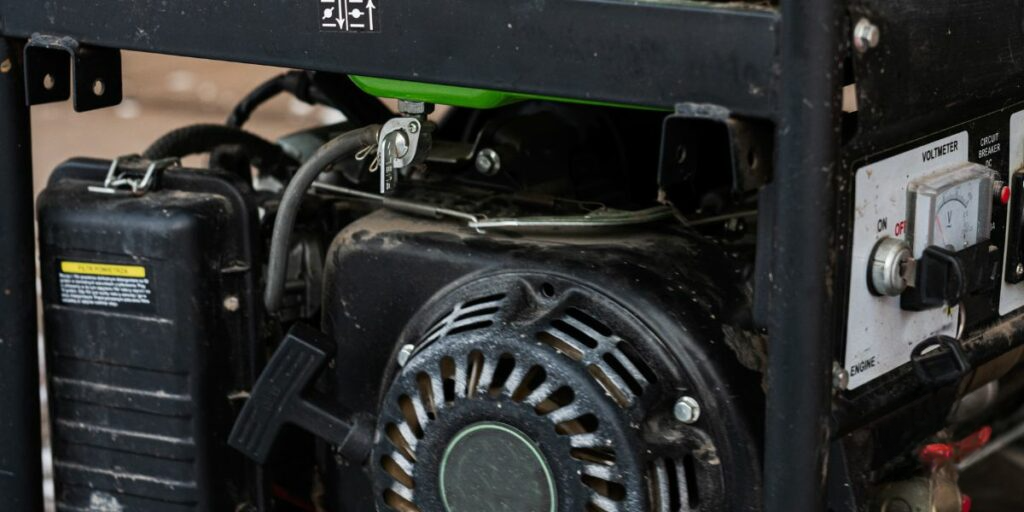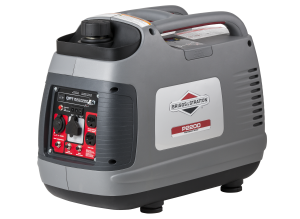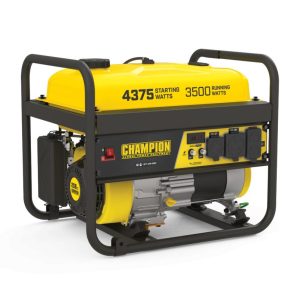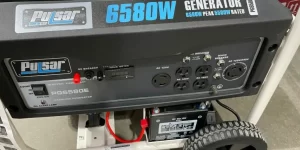12 Causes a RYOBI Generator to Turn On Then Die
Your generator kicked on, but it won’t keep going. I have compiled a list of potential causes of its repeated demise.
An empty gasoline tank, a clogged fuel filter, dirty carburetor, clogged fuel line, bad gas cap, dirty spark plug, faulty ignition coil, a lack of engine oil, or old gas can cause a RYOBI generator to start but subsequently shut down.
Do not attempt any repairs until the engine has cooled down and the spark plug wire has been removed. Make sure you’re taking all of the RYOBI-recommended safety measures.
Table of Contents
Your RYOBI Generator Starts, But Then Stops and Won’t Continue to Run
RYOBI Generator’s Gas Tank Is Empty
A RYOBI generator that runs on gas can’t provide power if there isn’t any. You may be so annoyed that you neglected to check this obvious cause, which is why I bring it up.
To solve this problem, set up a level surface for the generator. When the generator’s fuel gauge drops to “E,” it’s time to refuel.
Use of Outdated Fuel in a RYOBI Generator
There could be enough fuel in the generator, but it could be spoiled.
Ethanol is now often found in gas. This is an alternate fuel that can cause fuel system corrosion by attracting moisture.
Gasoline with water and ethanol in it will settle to the bottom of the tank. The gasoline system and the engine would be severely damaged by running on this mixture.
The residue it leaves behind, called varnish, clogs the fuel system and prevents the engine from receiving the necessary amount of fuel.
Gas loses its quality in as little as 30 days after purchase, therefore it’s best to utilize new gas and use it up as quickly as possible.
In my experience, this is far simpler said than done. Only during a power outage can you use the generator, and how long it lasts is anyone’s guess.
This is why you need to mix in a fuel additive with new gas before you put it in the tank. Sea Foam Motor Treatment is a gasoline stabilizer and moisture remover that can extend the fuel’s useful life.
If you want better fuel efficiency, try these tricks:
- Unleaded gasoline having an octane value of 87 or above and no more than 10% ethanol is recommended for use in 4-cycle RYOBI generators. Don’t fill up with fuel that has a high ethanol percentage.
- You should burn through your gas supply within 30 days.
- Gas should not be stored outside where it could be exposed to dampness.
- Maintain a dry location for gas storage.
- Don’t stock up on more gas than you can use within a month. Over and above this quantity, we recommend using a gasoline stabilizer.
The ANSWER is to transfer the used gas to a disposal container. A gasoline system can be stabilized and cleaned by using new fuel along with a fuel additive.
RYOBI Generator Fuel Filter Clogged
In order to filter fuel before it reaches the carburetor, many RYOBI portable generators incorporate an inline fuel filter between the fuel lines. The fuel system relies on this filter to prevent contamination from foreign particles.
The filter’s ability to retain dirt means that eventually it will become clogged, preventing fuel from getting through it. If the engine doesn’t get enough fuel, it could die.
REMEDY: Swap out the clogged fuel filter.
Your RYOBI Generator’s Blocked Fuel Line
Gluey residues from stale gas can clog up gasoline lines. Because of this, fuel flow is restricted on its way to the carburetor.
To monitor the flow rate of fuel from a particular segment of the fuel line, you can start and stop the fuel supply using the fuel shut-off valve.
The gasoline line must be disconnected from the generator in order to spray carburetor cleaning into the line and break up the obstruction. The next step is to use compressed air to blow through the line and clear out the obstruction. When necessary, the process can be repeated.
Fix the line’s mounting. If you find that the clog is too stubborn to remove or that your gasoline lines are dry and damaged, you may simply buy a new fuel line from an auto parts store or a hardware store and install it.
Your RYOBI Generator’s Fuel Pump Is Broken
When the carburetor is situated above the gasoline tank, your RYOBI generator will necessitate the usage of a fuel pump. Moving upward against gravity calls for the use of a pump.
To transfer gas from the tank to the carburetor, a vacuum fuel pump makes use of the engine’s exhaust vacuum. The generator will stop working if the fuel pump fails to supply gas to the carburetor.
Verify that fuel is reaching the fuel pump’s inlet port before proceeding with testing. Then, put the carburetor line in a storage container.
Turn on the motor and listen for a constant or pulsating stream to emerge from the hose.
In the event that your fuel pump is intermittently supplying fuel to the carburetor, you should replace it.
The Carburetor in Your RYOBI Generator Is Filthy
A carburetor is an engine part that combines fuel with combustion air.
Deposits left behind by old gas can clog fuel lines and stick internal carburetor parts. Your RYOBI generator may stop working if the engine doesn’t get enough fuel.
FIX: Clean your carburetor to get rid of the sludge and crust that forms from using old fuel or fuel containing ethanol. Rebuilding or replacing your carburetor may be necessary if it is severely soiled or missing parts.
Incorrect Choke Setting on a RYOBI Generator
When starting a chilly RYOBI generator, close the choke to limit airflow to the engine. To keep the engine running after it has warmed up, the choke must be moved to its open position.
If your engine fires up but immediately dies, check to see that the choke is open and turned off.
Clogged Air Filter
To prevent engine wear caused by dirt entering the air intake, an air filter is essential. This is a vital component; thus, it needs to be inspected frequently to ensure it stays in working order.
If you’re like most homeowners, you probably just clean or replace your air filter once a year. There comes a time when you need to change the filter because of how unclean it is or because it has been damaged.
If you are using the generator in dry, dusty conditions, you should expect to change it more frequently.
Failure to properly clean and replace the filter can lead to a buildup of dirt that prevents the engine from receiving enough air for proper operation. Overheating is a leading cause of irreparable engine damage.
If you discover that your air filter is clogged, you can clean it by following the steps outlined below.
Because there are several different types of air filters used by RYOBI in their various generator models, it is important to follow the maintenance instructions provided in the owner’s manual while cleaning your air filter.
Inadequate Gas Cap/Fuel Tank Vent
Ventilation in the gasoline tank allows for the release of any built-up pressure in the tank.
Because oxygen is being excluded from the tank, fuel consumption will be reduced when the vent is blocked. Tank vacuum prevents fuel from reaching the carburetor. In other words, the generator will not be able to function.
Using a pressure gauge, you can find out if the issue is related to the fuel tank vent. In the absence of a pressure gauge, you should not worry.
If you suspect a problem with your ventilation system, try the following:
- Start by letting go of the gas cap.
- Turn on the backup power. If the generator is functioning normally, you can test for the problem by loosening and then tightening the fuel cap.
- Let the generator keep running for as long as possible to determine if it slows down or stops working altogether.
- The gasoline tank vent is broken if the engine misbehaves and loses power until you release the cap and let air into the tank.
The gas cap may double as a vent for the fuel tank. It could also be a separate vent built on the gasoline tank’s top.
When the fuel tank stops venting properly, you can fix it by replacing the gas cap or the rollover valve, depending on the RYOBI model you have.
The RYOBI Generator’s Filthy Spark Plug
The spark plug was responsible for producing the spark that kicked off the engine’s ignition system, so if it’s unclean or damaged, the generator can sputter and die.
The problem can be solved by removing the spark plug and inspecting it. Replacement of the spark plug is required if the tip has turned a very dark color, the electrode is worn, or the porcelain is cracked.
If it seems in good shape, remove the spark plug wire and cleanse it with a wire brush before checking the electrode gap and reattaching it. Incorrect spark plug gap or a dangling wire are two more common causes of a stopped generator.
Your RYOBI Generator Has a Faulty Ignition Coil
Be sure the spark plug is fine before you start looking for a faulty ignition coil. The engine cannot be started without the ignition coil sending voltage to the spark plug.
A non-firing spark plug or malfunctioning ignition coil will prevent the engine from starting.
To fix this, examine the ignition coil’s connection to the starter. You should substitute the ignition coil if you notice a break in continuity.
Your RYOBI Generator Has Low Engine Oil
Occasionally, your RYOBI generator will work for a while and then shut off unexpectedly. Do a quick check to see if the low oil indicator light is on.
In order to prevent harm to the engine, RYOBI is equipped with a low-oil shutdown sensor. Restarting is impossible unless the engine oil level is adjusted.
It’s possible that the fact that it stops working is annoying. Still, it’s a good thing that the generator turned off.
Due to increased friction caused by insufficient lubrication, engine damage can be severe if it is allowed to continue running when oil levels are low. When the engine gets too hot, the components can melt.
FIRST, set the generator down on a level place so you can check the oil level. Take off the oil fill cap and use a dry towel to remove the oil from the dipstick.
The dipstick should be reinserted into the oil fill tube, but the lid should be left off. Take the dipstick out and check the oil level. Look at the dipstick and make sure it’s within the whole range.
Check to see if the engine oil is at the proper level, and if it isn’t, add or drain some oil to get it there. In cases where the engine oil level is correct yet the low oil warning light persists, a defective sensor may be to blame. It’s recommended that you get the generator checked out by a professional.








